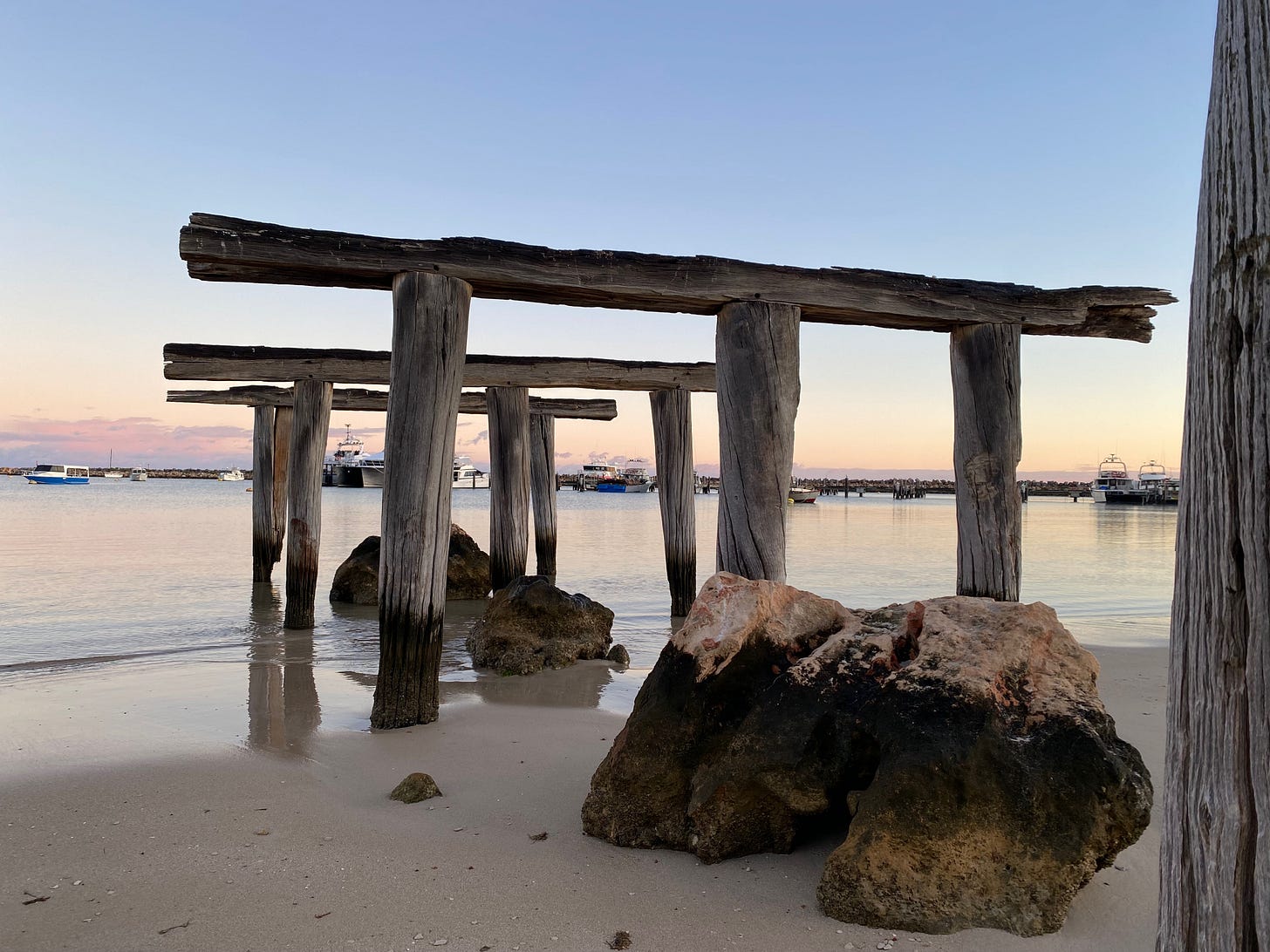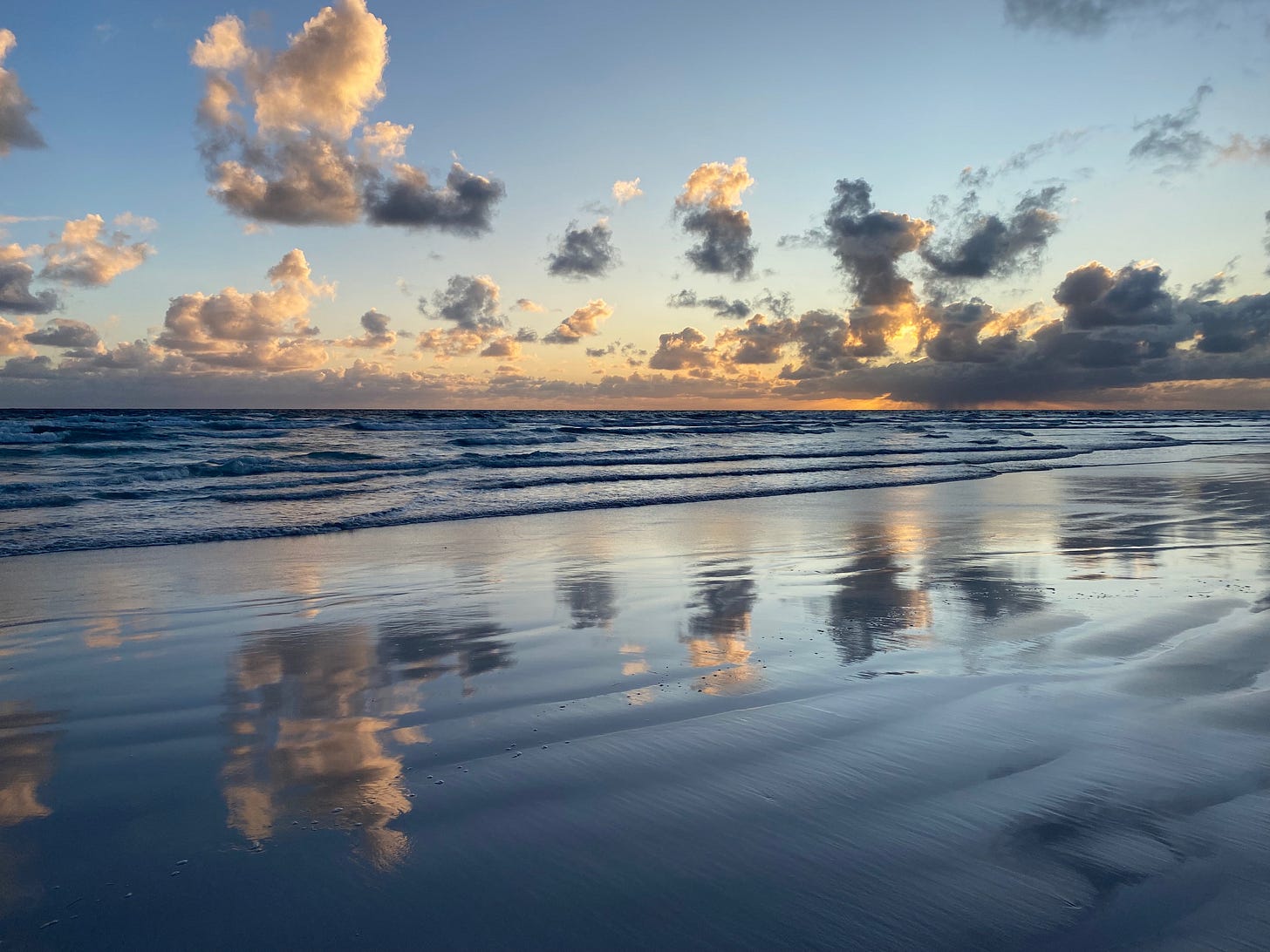During part of my recent journey to visit family and friends in Western Australia, I enjoyed once again the miles-long white sand beaches, the magnificent Indian Ocean, the big sky vistas - vital components of my childhood years. I joined a family holiday at Port Denison, a small fishing, lobstering and tourist town 40 miles south of Geraldton, my childhood “hometown”. Mornings of clear blue skies were followed by dramatic cloud formations pierced by brilliant rainbows, which usually cleared again to treat us to stunning sunsets - the low sky and remaining clouds tinted in gold, orange, scarlet, purple, green - the colors reflected upon the sea.
In my decades of living in northeast USA, I have never forgotten that big sky and big sea - the colors, scents, sounds of the restless surf that seem so particular to the Indian Ocean - the feel of soft sand under my toes, the splash of onrushing waves around my feet.
Sometimes, during those early years in Australia, my family would take long drives into the empty hinterland. It indeed seemed an endless stretch of emptiness - flat, stark desert landscape, long horizons and, for a few brief weeks in the September spring - carpeted with wildflowers. But the word - empty - is freighted with meaning - meaning we did not learn about in my country town schools back then in the fifties and sixties.
This word - empty - when applied to a land, such as Australia, contains the hubristic history of racism and genocide, displacement from home-lands, wonton sacrilege of sacred places and customs, destruction of cultures and traditions, forced removal of children, and ongoing wealth extraction that characterized the centuries of European colonialism on all continents.
While researching materials about the Assisted Passage Migration Scheme which began in 1945 - an Australian government program to encourage British citizens to emigrate to Australia - I came across a copy of the poster above. To my modern sensibility, the wording Unoccupied White Australia and Fill up thy frontiers, man the gate, before too late is shocking. But although that poster was clearly from an earlier time, its sentiments are not so far removed from other more modern 20th century posters that refer to an empty land full of opportunity for British people to populate and thrive. I don’t know how my parents learned of the Assisted Passage Migration Scheme - perhaps it was something like the poster below that caught their attention.
From 1945 to 1981 a million British emigrated to Australia on this Scheme, although about a quarter eventually returned to England. It was not easy for working class immigrants - apart from the cheap passage the Australian government was not giving land, or money, or benefits to the new settlers. Many spent months in migrant hostels, often just Nissen huts. Perhaps as part of the Bring Out a Briton campaign, my parents found an Australian family to “sponsor” and temporarily house us. This family happened to live in Geraldton, Western Australia - and so this port and agricultural centre, then of about 9,000 people, became our home. At the northern end of the coastal wheat belt, the town was perched between the sea and the barren interior that lay to the east and north.
Western Australia is the lowest, flattest and oldest landmass in the world. Parts of the landmass of Australia - particularly western and central - have existed as they are now for almost 4 billion years - without active tectonic faults to produce mountainous upthrusts or significant seismic activity.
Less well known - and until recently, less acknowledged - is the fact that Australia is also the home to the oldest continuous human cultures. The first human migration to Australia occurred at least 40,000 to 50,000 years ago, by sea from what is now southeast Asia - and some scientists now think this first migration could have been as long as 65,000 - 70,000 years ago. Studies of archeological sites around Australia suggest that for thousands of years the population remained low, but at some point the population grew across the land, such that upon European settlement beginning in 1788 there may have been a million or more aboriginal people living across the vast land, with different tribal groups and languages. What is clear is that human beings (yes - people!) settled Australia before homo sapiens people arrived in western or northern Europe.
Australia was definitely not an empty land in 1788, when a fleet of 2 naval vessels and 9 transport ships carrying 850 convicts, guards, officers and Governor Arthur Phillip set up the first British settlement on January 26th, 1788 in Sydney Cove.
In my next post, #26 What’s in a Voice I will discuss an upcoming referendum for an amendment to the Australian constitution that is aimed at affirming that Australian Aboriginal and Torres Strait Islander peoples are indeed the First Peoples to live in Australia, and to formalize a method by which they will have more of a voice in matters before the federal parliament.







Jo- I appreciate this journey through the definition of the word empty, Australia, and everything in between. Thanks for sharing.
Phyllis Beren
The posters are amazing as are the photos. Wanted to hear more.